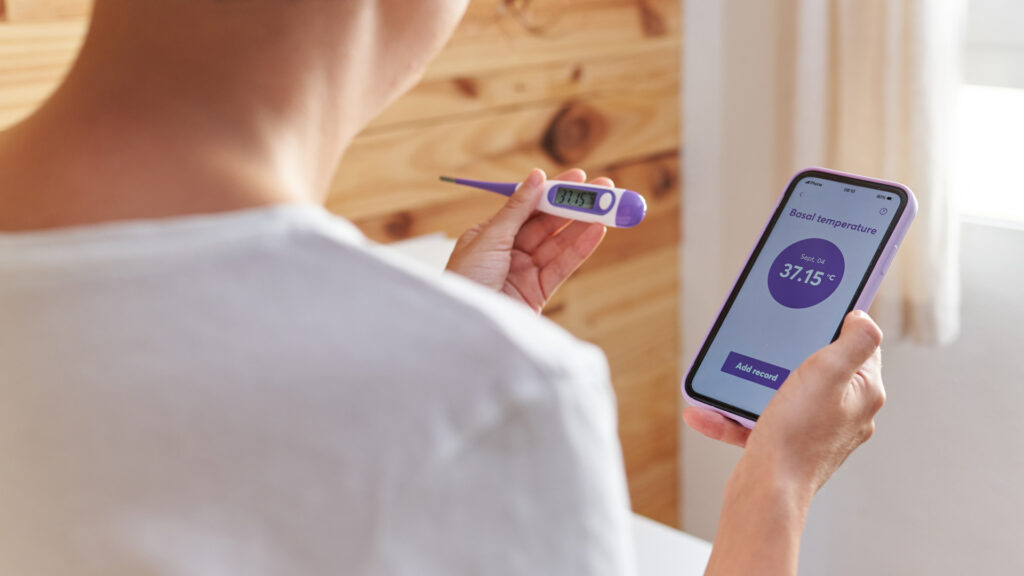Tracking your ovulation: here are the most effective methods
- READING TIME 7 MIN
- PUBLISHED November 02, 2023
- AUTHOR Donna
Key takeaways
- Are you planning a baby (or trying to avoid pregnancy)? Conception is all about ovulation. By pinpointing the days when it occurs, you can better time for baby-making sex – or understand when to double down on contraceptives.
- The most common methods for tracking ovulation include charting basal body temperature and examining cervical mucus. Also consider ovulation predictor kits to track hormonal changes before ovulation.
- You’ll have the best chances of determining ovulation by combining different methods.
Tracking your ovulation: here are the most effective methods
If you are trying to conceive, it helps to track ovulation and, that way, target the most fertile days of your cycle – also known as the fertile window. A typical fertile window lasts up to six days. It includes the five days leading up to ovulation (the time the motile sperm can survive inside a woman’s reproductive tract 1 ), plus the day of ovulation itself. Learn more about your fertile window in this article.
Best days for baby-making sex
Ovulation only lasts between 12 to 48 hours. It occurs when a mature egg is released from the ovary, pushed down the fallopian tube, where it waits to be fertilized by the sperm. If you know when you ovulate and want to have children, you can hedge your bet of conception by having sex a couple of days before and on the day of the ovulation.
While ovulation monitoring is helpful for couples with scheduling challenges or fertility problems, for others, having sex every two to three days offers almost the same chance of conceiving. Of course, sex can’t always be scheduled like a Zoom meeting and treating it that way will likely kill the mood eventually. Having an honest discussion with your partner will make the process much easier.
But in any case, you only have six days each month (at best!) to get pregnant. Taking the guesswork out of the ovulation prediction is still not a bad idea.

Signs of ovulation
During ovulation, your body changes to support a potential pregnancy. Your body temperature rises, the lining of the uterus thickens and the composition of the cervical fluid changes.
Other signs of ovulation may include breast tenderness, bloating, light spotting and cramping, also called mittelschmerz, which is a slight pain on one side of your abdomen. Some women also experience an increased sex drive. 2
How to know when you ovulate with regular periods
Start with identifying the length of your menstrual cycle. This is the number of days between the first day of bleeding of one period and the first day of bleeding of the next. Cycles are considered regular if they last from 21 to 35 days, with 28 days being the average. 3
The second part of the equation is the luteal phase – the time between ovulation and the first day of your next period. Like the length of your menstrual cycle, your luteal phase varies and can be anywhere from 10 to 15 days long. The average luteal phase is 14 days.
So, to determine the approximate day you ovulate, subtract 14 days from the end of your current cycle. In a “typical” 28-day menstrual cycle, for example, the fertile window will fall between days 10 and 17.
If you have regular periods, you can use a calendar to track ovulation. Keep track of at least six periods to get an accurate representation of your average cycle length.
But because the calendar method relies heavily on averages, it’s not always completely accurate. Your cycle and ovulation date can vary from cycle to cycle, even if you have regular periods. If you’re more irregular, give yourself a wider fertility window than the typical six days to account for any inaccuracies in the charting.
Irregular periods
Many women have irregular cycles or don’t experience any of the typical ovulation signs that would help orient during the cycle. In fact, 70 percent of women ovulate outside of a regular cycle frame, according to a study conducted in 2000. 4 The same study also found that for those women who have regular cycles, the day of ovulation was also highly unpredictable. Factors such as stress, diet, and sleep can also affect the length of your cycle and, with it, ovulation day.
Calculating your ovulation date with irregular menstrual cycles is more difficult. If you’re in this boat, there is still an assembly of methods to determine your fertile window. Individually, these methods have been shown to be between 76–88 percent accurate. 5 Combining them may increase effectiveness to almost 100 percent. Let’s look at the most popular options.
Basal body temperature
Basal body temperature (BBT) is your resting temperature – the temperature of your body before you start moving.
BBT is lower before ovulation and higher after ovulation has occurred. This slight increase (0.3 ºC to 0.6 ºC) in temperature is caused by increased progesterone levels that are associated with ovulation. 6 When a rise in temperature is sustained for at least three days, it’s a good indication that ovulation has occurred.

Chart your BBT for at least three months to get an accurate prediction of your fertile window. For this method to work, you’ll need to have a thermometer ready and take your temperature first thing in the morning, before you get out of bed.
In some cases, BBT charting may even offer a hint as to whether you have conceived or not. This is known as the “implantation dip.”
Ovulation urine tests
Ovulation predictor kits are in a lot of ways like home pregnancy tests. They analyze urine for increased luteinizing hormone (LH) levels that is responsible for triggering ovulation. When the hormone starts surging, it typically indicates that you will ovulate within 28 to 36 hours. 7 Note that these tests come in a bundle because you’ll need to take one every day over at least five days to accurately detect the start of ovulation.
Once the test predicts ovulation, you should have unprotected sex daily for the next couple of days to increase your chances of pregnancy. And don’t forget to record all the findings on your calendar. After a couple of months, you may come upon a pattern of ovulation and time sex before the hormone surge without taking the test.
Saliva ferning tests
Saliva testing is less common but still another way to detect ovulation. The test relies on the chemical changes that occur during ovulation. These changes can be observed in a form of fern-like crystals that aren’t present at any other stages in the cycle except during the fertile period.
The test kit includes a lens onto which you place a drop of your saliva. After five minutes and when the saliva sample dries up, view the residue under the scope to see if any crystals have developed. Ovulation is likely to occur within 24 to 72 hours of the first formations.
Tracking cervical mucus changes
Keeping a close eye on your cervical mucus can also help you track your ovulation days. Cervical mucus is a fluid produced by the cervix. Its job is to nourish and transport sperm through the cervix and into the uterus during your fertile window.
Around the time of ovulation, the cervical mucus gets watery. When you ovulate, it becomes translucent, looking like raw egg whites. In other, less fertile parts of the cycle, cervical mucus is typically drier and stickier. 8
The method is pretty straightforward – simply insert a clean finger into your vagina and note the color and texture of the sample. You could first ask your gynecologist to help you decode the differences in mucus consistency. Also note that medications, hygiene products or sex can all change the look of your cervical mucus. Check your mucus every day (except during your period) and record the results on a chart.
The cervical mucus method is supposed to be 97% accurate. 9 When combined with calendar tracking and measuring basal body temperature, it’ll be almost impossible to miss your ovulation.

Cervical Position Method
Speaking of the cervix, the position, firmness and openness of the canal also change during the menstrual cycle.
At the beginning of the cycle, your cervix is typically firmer, more closed and it sits lower in your vagina. As you approach ovulation, it moves up higher, opens slightly, and becomes softer. By examining your cervical position, you also better understand when you’re approaching ovulation.
What if you just can’t get pregnant
If you feel you’re doing everything you can to nail ovulation days and time sex accordingly, but nothing happens, consider seeking professional advice. In most countries, you’re entitled to fertility assistance after 12 months of unsuccessful attempts. If you are over 35 years of age, you may get support after only 6 months. Jump over to our article here for more information on fertility issues and what options you have at your disposal.
REFERENCES
- https://www.ucsfhealth.org/education/conception-how-it-works
- https://www.nhs.uk/common-health-questions/womens-health/how-can-i-tell-when-i-am-ovulating/
- https://www.nature.com/articles/s41746-019-0152-7
- https://www.ncbi.nlm.nih.gov/pmc/articles/PMC27529/
- https://www.plannedparenthood.org/learn/birth-control/fertility-awareness
- https://www.ncbi.nlm.nih.gov/books/NBK546686/
- https://pubmed.ncbi.nlm.nih.gov/6821195/
- https://www.med.unc.edu/timetoconceive/study-participant-resources/cervical-mucus-testing-information/
- https://www.cdc.gov/mmwr/preview/mmwrhtml/rr6304a5.htm
RELATED ARTICLES
Explore more
Feed your curiosity with more content. Dive deeper and explore our selected articles, curated just for you.




